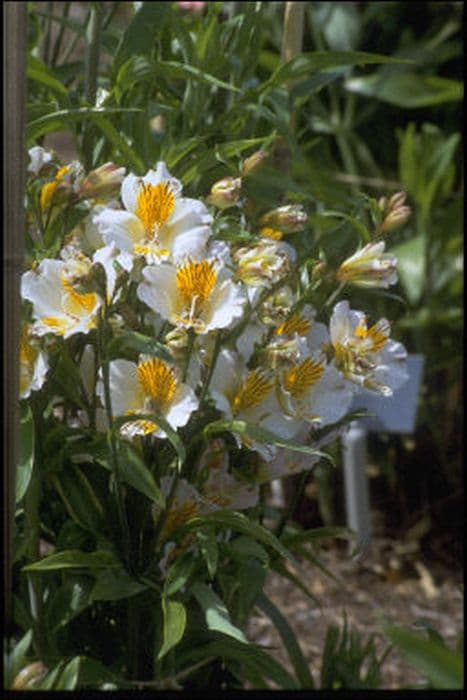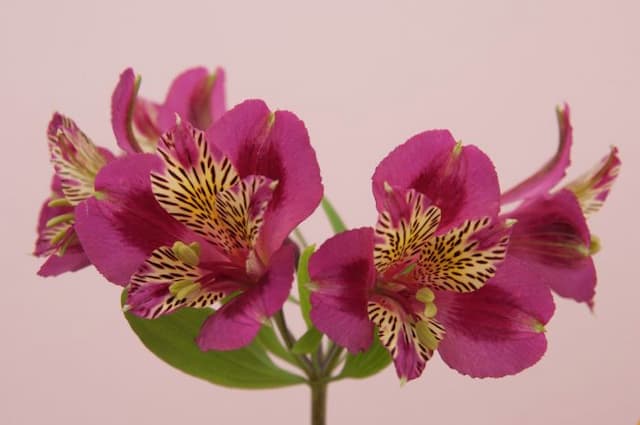Peruvian Lily Alstroemeria Inca Milk = 'Koncamilk' (Inca Series)
![Peruvian lily [Inca Milk]](/_next/image?url=https%3A%2F%2Fplants-admin.emdemapps.com%2Fimages%2Fplants%2F%2Fimages%2F604b5f14b0b6a.png&w=3840&q=75)
ABOUT
The Alstroemeria Inca Milk, also known as Peruvian Lily or Lily of the Incas, is a captivating plant that features a lush display of foliage accompanied by distinctive and attractive blooms. The leaves of this plant are narrow, lance-shaped, and have a fresh, green hue which form a dense, bushy appearance. Characteristic to the Alstroemeria, the leaves may appear to twist, causing the bottom side to face upward. The flowers are the most striking aspect of the Inca Milk variety. They come in a delightful creamy-white color, often adorned with subtle, pinkish or peach brush strokes that accentuate their delicate beauty. The inner petals typically exhibit a speckling pattern of darker spots, providing a contrast that enhances their visual impact. Each bloom comprises six petals with a symmetrical arrangement that adds to the plant's overall elegance. The Peruvian Lily's inflorescence clusters together at the top of the stems, creating a showy display that can be reminiscent of a mini floral bouquet. This charming appearance not only makes the plant an excellent choice for garden beds and borders but also a popular candidate for cut flower arrangements, where the soft colors and intricate petal patterns can be appreciated up close.
About this plant
 Names
NamesFamily
Alstroemeriaceae
Synonyms
Peruvian Lily, Lily of the Incas, Inca Lily
Common names
Alstroemeria Inca Milk = 'Koncamilk' (Inca Series).
 Toxicity
ToxicityTo humans
Alstroemeria, also known as Peruvian Lily or Lily of the Incas, is not generally considered toxic to humans. However, like many plants, it may cause mild irritation if ingested or if the sap comes into contact with skin. If ingested in large quantities, symptoms may include mild gastrointestinal discomfort, nausea or vomiting. While significant toxicity or poisoning from this plant is rare, it is always advisable to keep all plants out of the reach of small children who may inadvertently ingest plant material.
To pets
The Peruvian Lily is considered to be mildly toxic to cats and dogs if ingested. The symptoms of poisoning in pets can include vomiting, diarrhea, and drooling. In some cases, it may also result in mild dermatitis if the sap comes into contact with their skin. If a pet ingests a large amount of the plant, it should be taken to a vet for evaluation and care. Always ensure pets do not have access to plants that could potentially be harmful.
 Characteristics
CharacteristicsLife cycle
Perennials
Foliage type
Evergreen
Color of leaves
Green
Flower color
Pink
Height
2-3 feet (60-90 cm)
Spread
1-2 feet (30-60 cm)
Plant type
Herb
Hardiness zones
7
Native area
South America
Benefits
 General Benefits
General Benefits- Long Blooming Period - The plant often has a long flowering season, providing color and vibrancy in the garden for an extended period.
- Attracts Pollinators - Alstroemeria is known for attracting bees, butterflies, and other beneficial insects that contribute to pollination in the garden.
- Low Maintenance - Once established, it requires minimal care, making it a convenient choice for busy gardeners.
- Drought Tolerant - It can survive periods of limited water, which is beneficial in areas prone to drought or for water-wise gardening practices.
- Versatile Use - Suitable for borders, containers, and as cut flowers, providing flexibility in garden design and indoor decoration.
- Cut Flower Longevity - The blooms can last up to two weeks in a vase, making them excellent for floral arrangements.
- Vivid Colors - The plant produces vibrant and colorful flowers that can brighten up any garden space.
- Cold Tolerant - It can endure cooler temperatures, which makes it suitable for a variety of climates.
 Medical Properties
Medical PropertiesThis plant is not used for medical purposes.
 Air-purifying Qualities
Air-purifying QualitiesThis plant is not specifically known for air purifying qualities.
 Other Uses
Other Uses- Photography Props: Alstroemeria flowers can be used as photography props due to their bright colors and intricate patterns, enhancing the composition of close-up or macro photography.
- Artistic Inspiration: Artists might use the vibrant hues and unique shapes of Alstroemeria petals as inspiration for paintings, textiles, or other art forms.
- Educational Tool: Educators could use Alstroemeria in lessons about botany, plant hybridization, or flower structure to provide students with a hands-on learning experience.
- Culinary Decoration: While not widely known for their culinary use, Alstroemeria flowers can be used as non-toxic garnishes to add a splash of color to salads and desserts.
- Therapeutic Horticulture: Gardening with Alstroemeria can be beneficial for mental health, offering therapeutic activities to those in horticultural therapy programs.
- Floral Crafts: The petals and leaves of Alstroemeria can be used in crafting, such as making pressed flower bookmarks or natural dyes for fabrics.
- Wedding Confetti: Dried Alstroemeria petals can serve as an eco-friendly alternative to traditional wedding confetti, adding a unique touch to celebrations.
- Seasonal Decorations: The flowers can be incorporated into wreaths, centerpieces, or other decorations for events and seasonal festivities.
- Environmental Education: Alstroemeria can be part of a butterfly or bee garden, serving as an educational tool to teach about pollinators and their role in the ecosystem.
- Color Theory Demonstrations: Mixing Alstroemeria petal pigments with water can provide a simple way to teach children about primary and secondary colors.
Interesting Facts
 Feng Shui
Feng ShuiThe Peruvian Lily is not used in Feng Shui practice.
 Zodiac Sign Compitability
Zodiac Sign CompitabilityThe Peruvian Lily is not used in astrology practice.
 Plant Symbolism
Plant Symbolism- Friendship: Alstroemeria, commonly known as Peruvian Lily or Lily of the Incas, is often associated with deep bonds and the lasting connection between friends, likely due to its intertwining growth habit.
- Devotion: The Peruvian Lily symbolizes the commitment and dedication one person feels toward another, suggesting a mutual support and steadfastness.
- Wealth and Prosperity: The flower's abundance of petals and striking colors can represent a richness of life or the desire for success and prosperity.
- Achievement: Given as a gift, the Peruvian Lily can symbolize the celebration of achievements and the recognition of hard work.
- Fortitude: The resilience and ability of the Alstroemeria flower to grow in various conditions can signify personal strength and the courage to face challenges.
 Water
WaterPeruvian lilies, including the Alstroemeria Inca Milk, prefer regular watering to keep their soil moist but not waterlogged. Water the plant about once a week with approximately one to two gallons, depending on the size of the plant and the weather conditions. During hot, dry spells, you may need to water more frequently to prevent the soil from drying out completely. Always check the top inch of soil for dryness before watering again.
 Light
LightPeruvian lilies like Alstroemeria Inca Milk thrive in full sun to partial shade conditions. They perform best when they receive at least six hours of sunlight daily. A spot that gets morning sunlight but is shaded during the hottest part of the afternoon is ideal to prevent potential leaf scorch.
 Temperature
TemperaturePeruvian lilies such as Alstroemeria Inca Milk prefer temperatures ranging from 65 to 80 degrees Fahrenheit. They can survive minimum temperatures down to about 23 degrees Fahrenheit, but for optimal growth, maintain a temperature above freezing. The roots are hardy to a point but prolonged exposure to extreme cold can be damaging.
 Pruning
PruningPruning Peruvian lilies, including Alstroemeria Inca Milk, encourages bushier growth and more flowers. Pinch or cut off spent flowers regularly to promote continuous blooming. In late fall, cut back the entire plant after the first frost to help rejuvenate it for the next season. Prune any damaged or dead growth as needed throughout the year.
 Cleaning
CleaningAs needed
 Soil
SoilThe Peruvian Lily Inca Series thrives in moist, well-draining soil with a pH between 6.0 and 7.0. For optimal growth, a mixture of two parts peat or coir, one part perlite or coarse sand, and one part loamy soil will provide the necessary nutrients and drainage. Regularly adding organic matter can enhance soil fertility.
 Repotting
RepottingPeruvian Lilies from the Inca Series should be repotted every two to three years to refresh the soil and accommodate root growth. Avoid repotting too frequently as they prefer to become somewhat root-bound which helps to stimulate flowering.
 Humidity & Misting
Humidity & MistingModerate humidity levels are ideal for the Peruvian Lily Inca Series, aiming for a range of 40-60%. However, they can tolerate lower humidity levels as long as the soil moisture is maintained and they are not subjected to drafts.
 Suitable locations
Suitable locationsIndoor
Place in bright, indirect light and keep soil consistently moist.
Outdoor
Choose a sunny spot with afternoon shade and shelter from winds.
Hardiness zone
7-10 USDA
 Life cycle
Life cycleThe life cycle of the Alstroemeria, also known as Peruvian Lily or Lily of the Incas, begins with seed germination, which occurs in temperatures between 65 to 75°F and requires light, so seeds are sown on the surface of a well-drained growing medium. After germination, seedlings develop into juvenile plants, featuring the growth of foliage and roots, until they mature enough to transplant. Throughout the growing season, Alstroemeria produces multiple stems from its tuberous root system; the stems bear lance-shaped leaves and a profusion of showy, colorful flowers. After blooming, which can occur multiple times from late spring to early fall depending on the climate, it enters a dormancy period where growth slows, and the plant conserves energy, typically in response to cooler temperatures and shorter days. During dormancy, the above-ground parts of the plant may die back, but the underground rhizomes and tubers survive to sprout again the next season. With proper care, an Alstroemeria plant can live and continue its cycle for many years, offering long-lasting cut flowers and vibrant garden blooms.
 Propogation
PropogationPropogation time
Spring to Summer
The Alstroemeria, often known as the Peruvian Lily or Lily of the Incas, is a beautiful and popular perennial that can be propagated through division. This is most effectively done in the late summer to fall, after flowering has ceased but while the plant is still active. To propagate by division, the plant should be carefully lifted from the ground, taking care to keep the root ball intact. Using a sharp knife or spade, the clump should be divided into smaller sections, ensuring that each new section has at least one shoot and a portion of the root system. These divisions should then be replanted at the same depth they were growing originally, spaced approximately a foot (about 30 centimeters) apart to allow sufficient room for growth. Water the new divisions thoroughly to help establish them. This method allows gardeners to create new plants that are genetically identical to the parent, maintaining the desired traits of the Alstroemeria Inca Milk = 'Koncamilk' (Inca Series).






![Peruvian lily [Inca Coral]](/_next/image?url=https%3A%2F%2Fplants-admin.emdemapps.com%2Fimages%2Fplants%2F%2Fimages%2F604b5b79b85ce.png&w=640&q=75)
![Peruvian lily [Inca Exotica]](/_next/image?url=https%3A%2F%2Fplants-admin.emdemapps.com%2Fimages%2Fplants%2F%2Fimages%2F604b5ec0e34a9.png&w=640&q=75)
![Peruvian lily [Inticancha White Pink Blush]](/_next/image?url=https%3A%2F%2Fplants-admin.emdemapps.com%2Fimages%2Fplants%2F%2Fimages%2F604b538014919.png&w=640&q=75)
![Peruvian lily [Inticancha White]](/_next/image?url=https%3A%2F%2Fplants-admin.emdemapps.com%2Fimages%2Fplants%2F%2Fimages%2F604b5cab55909.png&w=640&q=75)